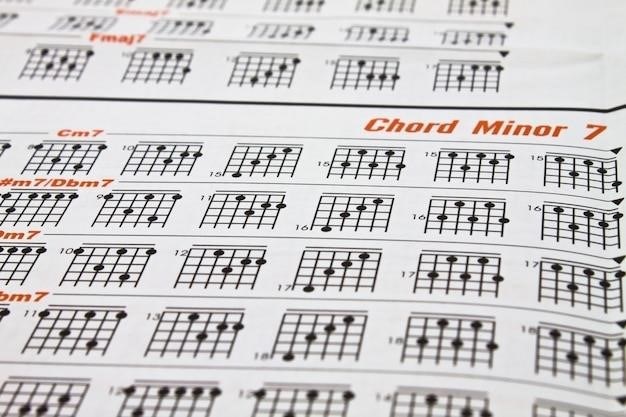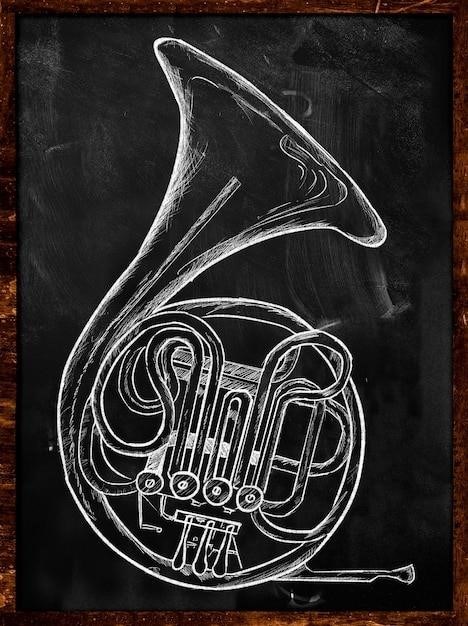French Horn Fingering Charts⁚ A Comprehensive Guide
A French horn fingering chart is an essential tool for any horn player, whether you’re a beginner or a seasoned professional․ These charts provide a visual representation of the fingerings for different notes on the horn, making it easier to learn and remember them․ They’re particularly helpful for navigating the complex harmonic series of the French horn, which often requires multiple fingerings for the same note․
Understanding French Horn Fingerings
French horn fingerings are based on the instrument’s unique harmonic series, which is a set of naturally occurring overtones produced when a brass instrument is played․ Unlike other brass instruments, the French horn relies heavily on these harmonics, making its fingering system more complex․
The French horn has three valves, each of which changes the length of the tubing, thereby altering the pitch of the note produced․ By combining different valve combinations, players can access a wide range of notes․
It’s important to note that the same note can often be played with multiple fingerings, and the choice of fingering can affect the sound quality, intonation, and ease of playing․
For example, the note “C” can be played with the following fingerings⁚
- 0 (no valves depressed)
- 1 (first valve depressed)
- 2 (second valve depressed)
- 3 (third valve depressed)
Each fingering will produce a slightly different tone and response, so players must experiment to find the most suitable fingering for specific musical contexts․
Types of French Horns
The French horn family encompasses a variety of instruments, each with its own unique characteristics and fingering considerations․ Understanding these differences is crucial when using a fingering chart, as the fingerings may vary slightly depending on the type of horn you’re playing․
Here are the most common types of French horns⁚
- Single F Horn⁚ The most basic type of French horn, the single F horn is tuned to the key of F․ It’s typically used for solo and orchestral playing․
- Single Bb Horn⁚ This type of horn is tuned to the key of Bb and is often used for marching bands and brass ensembles․
- Double Horn⁚ The most versatile type of French horn, the double horn has both F and Bb sides․ This allows players to easily switch between keys without having to change instruments․
- Triple Horn⁚ A relatively rare type of horn, the triple horn has three sides⁚ F, Bb, and high F․ This allows for even greater versatility in key and range․
- Descant Horn⁚ A smaller and higher-pitched horn, the descant horn is often used in chamber ensembles and for solo performances․
The specific fingerings for each type of horn may vary slightly, so it’s essential to use a fingering chart that is designed for the instrument you’re playing․
The Importance of a Fingering Chart
A fingering chart serves as a vital guide for any French horn player, regardless of skill level․ It acts as a roadmap, simplifying the complex world of horn fingerings and making the learning process smoother․ The French horn’s unique harmonic series, which differs from other brass instruments, often requires multiple fingerings for the same note, leading to potential confusion․
Here’s why a fingering chart is indispensable⁚
- Memorization Aid⁚ Mastering the fingerings for all the notes on the French horn can be a daunting task․ A fingering chart provides a visual reference, helping you learn and memorize fingerings efficiently, especially for those challenging intervals or notes․
- Accuracy and Consistency⁚ The French horn is known for its demanding intonation․ Using a fingering chart ensures you’re using the correct fingerings, leading to more accurate and consistent pitch․
- Exploration and Experimentation⁚ Fingering charts can be a valuable tool for exploring alternate fingerings and discovering different tonal colors․ They can help you find fingerings that best suit your personal playing style and the specific musical context․
- Confidence Building⁚ Having a reliable fingering chart at hand can boost your confidence․ Knowing you have a visual guide to refer to can alleviate performance anxiety and allow you to focus on your musical expression․

In essence, a fingering chart acts as a trusted companion, making the journey of learning and playing the French horn more accessible and enjoyable․
Reading a Fingering Chart
Understanding how to read a French horn fingering chart is crucial for utilizing it effectively․ Most charts are organized in a straightforward manner, but some nuances require attention;
Here’s a breakdown of the key elements to decipher⁚
- Note Notation⁚ The chart will typically list notes in a musical notation format, usually with a treble clef․ This allows you to easily identify the specific pitches you’re seeking․
- Fingering Representation⁚ Fingerings are generally indicated with numbers, representing the valves to be pressed․ For example, “1” indicates the first valve, “2” the second, and “3” the third․ Some charts may use “0” to signify no valves pressed․
- Double Horn Considerations⁚ If you’re using a double horn, charts often include fingerings for both the F and Bb sides․ Look for notations like “F” and “Bb” or “T” (for trigger) to identify the appropriate fingering for your current side․
- Alternate Fingerings⁚ You’ll frequently see multiple fingerings listed for a single note․ This is because the French horn’s harmonic series allows for various combinations of valves to produce the same pitch․ The chart may specify which fingerings are preferred or offer different tonal options․
- Partial Information⁚ Some charts may also include information about the “partial” or harmonic series the note belongs to․ Understanding partials can help you grasp the underlying physics of horn playing․
With practice and a bit of familiarity, reading a French horn fingering chart will become second nature, aiding you in confidently navigating the instrument’s unique fingerings․
Common Fingerings for the French Horn
While a comprehensive French horn fingering chart covers a wide range of notes, certain fingerings are particularly common and essential to master․ These frequently used fingerings form the foundation of your horn playing and are essential for building a solid technical foundation․
Here are some of the most common fingerings you’ll encounter⁚
- Low C⁚ The low C, often considered the starting point for many horn players, is typically played with no valves pressed (0)․
- F⁚ The F above low C is often played with the first valve (1), though alternative fingerings exist․
- Bb⁚ The Bb above F is usually played with the second valve (2) or a combination of the first and third valves (13)․
- D⁚ The D above Bb is often played with the first and second valves (12)․
- G⁚ The G above D is typically played with the second and third valves (23)․
- C⁚ The C above G can be played with the third valve (3) or a combination of the first and second valves (12)․
- E⁚ The E above C is often played with the second valve (2) or a combination of the first and third valves (13)․
These fingerings are a starting point for learning the French horn․ As you progress, you’ll explore more intricate fingerings, including those for higher notes and partials․ Consistent practice and familiarity with these common fingerings will make your horn playing more fluid and efficient․
Fingering Charts for Different Horn Types
The French horn comes in several variations, each with its unique characteristics and fingering requirements․ It’s crucial to use a fingering chart designed specifically for the type of horn you play to ensure accurate intonation and efficient playing․
Here are some common horn types and their associated fingering charts⁚
- Single F Horn⁚ This is the most basic type of French horn, with a single set of valves and a bore that produces an F pitch․ Fingering charts for single F horns are relatively straightforward, focusing on the fundamental harmonic series․
- Double Horn⁚ The double horn features two sets of valves, allowing players to switch between F and Bb pitches․ These charts typically list fingerings for both sides, often using a “T” to indicate the use of the trigger or fourth valve to switch between the F and Bb sides․
- Mellophone⁚ The mellophone is a valved brass instrument similar to the French horn but with a shorter, more compact design․ While the fingering charts for mellophones are similar to those for single F horns, there may be minor adjustments due to the instrument’s unique construction․
- Descant Horn⁚ The descant horn is a smaller, higher-pitched variant of the French horn, often used in chamber ensembles or brass quintets․ These horns have their own specific fingering charts, taking into account their higher range and smaller size․
- Triple Horn⁚ The triple horn features three sets of valves, allowing for even greater versatility in pitch and range․ Fingering charts for triple horns are the most complex, reflecting the instrument’s expanded capabilities․
It’s crucial to choose the fingering chart that corresponds to your specific instrument to ensure accurate fingering and optimal performance․ Remember, each horn type has its unique characteristics and fingering requirements․
Fingering Charts for Double Horns
Double horns, the most prevalent type of French horn today, offer players a unique versatility by allowing them to switch between F and Bb pitches․ This versatility demands a specialized fingering chart that accounts for both sides of the instrument․ These charts are typically presented with two sets of fingerings, one for the F side and another for the Bb side․
A common convention used in double horn fingering charts is the inclusion of a “T” to signify the use of the trigger or fourth valve․ This valve allows players to switch between the F and Bb sides of the instrument․ For example, a fingering that reads “T12” indicates that the trigger and the first and second valves should be depressed, resulting in a Bb note on the Bb side of the horn․
When using a double horn fingering chart, it’s essential to understand the context of each fingering․ The F side fingerings typically appear above the Bb side fingerings, and the “T” notation will only apply to the Bb side fingerings․ Furthermore, some charts may include alternate fingerings for specific notes, providing players with options for adjusting tone color or achieving specific effects;
Mastering the art of double horn playing requires a thorough understanding of both F and Bb side fingerings․ A comprehensive fingering chart, designed specifically for double horns, is an invaluable tool for navigating the complexities of this versatile instrument․

Advanced Fingering Techniques
While standard fingering charts provide a foundation for playing the French horn, experienced players often employ advanced techniques to achieve specific tonal qualities, improve intonation, or access extended ranges․ These techniques can be particularly useful for navigating challenging passages and expressing nuances in musical performance․
One such technique involves the use of “alternate fingerings․” These fingerings, often indicated in parentheses on fingering charts, offer players alternative ways to produce a particular note․ For example, a high F might be played using a standard fingering or a more open fingering․ The choice of fingering can affect the tone color, response, and overall quality of the sound․
Another advanced technique involves “partial shifting․” This technique allows players to access notes beyond the typical range of the horn by manipulating the harmonic series․ A player might use a fingering designed for a lower partial to access a higher partial, achieving a unique tonal quality and extending the instrument’s range․
Advanced fingering techniques often require careful practice and a deep understanding of the French horn’s harmonic series․ By exploring these techniques, horn players can expand their musical vocabulary, enhance their expressiveness, and achieve a greater level of mastery on the instrument․
Using a Fingering Chart Effectively
While a fingering chart provides a valuable reference point for horn players, effectively utilizing it requires understanding its structure and applying it to your practice and performance․ Mastering a fingering chart involves more than simply memorizing finger combinations; it’s about developing a deeper understanding of the instrument’s mechanics and its relationship to the harmonic series․
Begin by familiarizing yourself with the chart’s layout․ Most charts are organized by note, with fingerings listed in columns or rows․ Pay attention to any symbols or abbreviations used, such as those indicating valve combinations or alternate fingerings․ As you practice, refer to the chart frequently, gradually transitioning to recalling fingerings from memory․
When practicing, focus on achieving a clear and consistent sound for each note․ Experiment with different fingerings, exploring the tonal nuances each offers․ Pay attention to your embouchure and breathing, as these factors significantly impact the sound produced․ Remember that a fingering chart is a guide, and the best fingering for a particular note can vary depending on individual preferences and musical context․
Ultimately, using a fingering chart effectively involves a combination of technical proficiency, musical sensitivity, and a willingness to experiment․ By diligently practicing and developing a deep understanding of the chart’s information, horn players can unlock the full potential of their instrument and achieve a level of artistry that transcends mere fingerings․
Tips for Choosing the Right Fingering Chart
Navigating the vast array of French horn fingering charts available can be overwhelming, but choosing the right one is crucial for a successful learning journey․ Consider these factors when selecting a chart that best suits your needs and instrument type⁚
First, determine the type of horn you play․ Charts are often tailored for specific instruments like single F horns, double horns, or mellophones․ Ensure the chart aligns with your instrument’s configuration to avoid confusion․ Next, consider your skill level․ Beginners might benefit from simplified charts focusing on essential fingerings, while more experienced players may prefer comprehensive charts encompassing a wider range of notes and advanced techniques․
Moreover, prioritize clarity and organization; Charts with clear notation, organized layouts, and easy-to-understand symbols facilitate comprehension and memorization․ Look for charts with visual aids like diagrams or color-coding to enhance learning․ Additionally, consider the source of the chart․ Reputable sources, like music schools, instrument manufacturers, or established musicians, often provide reliable and accurate fingering charts․
Ultimately, the best fingering chart is the one that resonates with your learning style and preferences․ Don’t hesitate to try different charts and experiment until you find one that feels comfortable and facilitates your progress․ Remember, a well-chosen fingering chart can be a valuable companion on your journey as a horn player․
